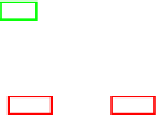Information Technology Reference
In-Depth Information
ζ
N
+1
=
m
(
x
N
+1
)
Λ
−
N
x
N
+1
m
(
x
N
+1
)
x
N
+1
Λ
−
N
x
N
+1
+
τ
−
1
N
+1
−
1
,
(5.51)
w
N
+1
=
w
N
+
ζ
N
+1
y
N
+1
−
w
N
x
N
+1
,
(5.52)
Λ
−
N
+1
=
Λ
−
N
ζ
N
+1
x
N
+1
Λ
−
N
−
.
(5.53)
This form of the Kalman filter is known as the
covariance form
as it operates
on the covariance matrix
Λ
−
1
rather than the precision matrix
Λ
.
The value
ζ
N
+1
is the
Kalman gain
and is a temporary measure that depends
on the current model
ω
N
and the new observation. It mediates how much
ω
N
is
corrected, that is, how much the current input
x
N
+1
influences
Λ
−
N
+1
, and how
the output residual
y
N
+1
−
w
N
x
N
+1
contributes to computing
w
N
+1
.
As the measurement noise variance
τ
−
1
N
+1
approaches zero, the gain
ζ
N
+1
weights the output residual more heavily. On the other hand, as the weight
covariance
Λ
−
N
approaches zero, the gain
ζ
N
+1
assigns less weight to the output
residual [233]. This is the behaviour that would be intuitively excepted, as low-
noise observations should influence the model parameters more strongly than
high-noise observations. Also, the gain is mediated by the matching function
and in the cases of non-matched inputs reduced to zero, which causes the model
parameters to remain unchanged.
Inverse Covariance Form
Using the Kalman filter to estimate the system state requires the definition of a
prior
ω
0
. In many cases, the correct prior is unknown and setting it arbitrarily
might introduce an unnecessary bias. While complete lack of information can
be theoretically induced as the limiting case of certain eigenvalues of
Λ
−
0
going
to infinity [164, Chap. 5.7], it cannot be used in practice due to large numerical
errors when evaluating (5.51).
This problem can be dealt with by operating the Kalman filter in the
inverse
covariance form
rather than the previously introduced covariance form. To up-
date
Λ
rather than
Λ
−
1
we substitute
ζ
N
+1
from (5.51) into (5.53) and apply
the Matrix Inversion Lemma (for example, [105, Chap. 9.2]) to get
Λ
N
+1
=
Λ
N
+
m
(
x
N
+1
)
τ
N
+1
x
N
+1
x
N
+1
.
(5.54)
The weight update is derived by combining (5.51) and (5.53) to get
ζ
N
+1
=
m
(
x
N
+1
)
τ
N
+1
Λ
−
N
+1
x
N
+1
,
(5.55)
which, when substituted into (5.52), gives
w
N
+1
=
w
N
+
m
(
x
N
+1
)
τ
N
+1
Λ
−
N
+1
x
N
+1
(
y
N
+1
−
w
N
x
N
+1
)
.
(5.56)
Pre-multiplying the above by
Λ
N
+1
and substituting (5.54) for the first
Λ
N
+1
of the resulting equation gives the final update equation
Λ
N
+1
w
N
+1
=
Λ
N
w
N
+
m
(
x
N
+1
)
τ
N
+1
x
N
+1
y
N
+1
.
(5.57)






Search WWH ::

Custom Search